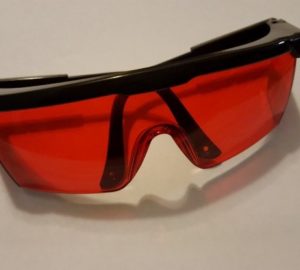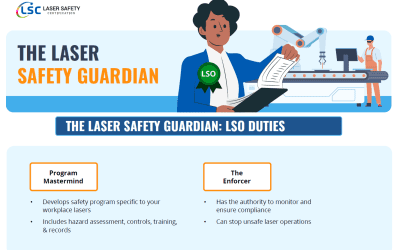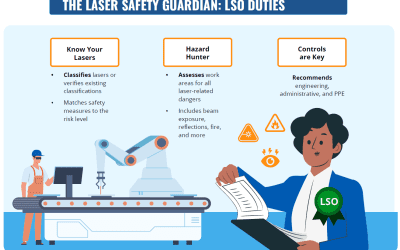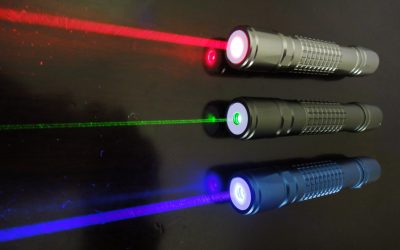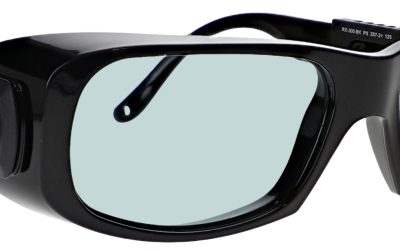The A-B-C’S Of Proper Laser Safety Glass Usage
The most common laser injuries – and most easily avoided – are to the retina. The retina is made up of light-sensitive cells. These cells tell the brain to form a visual image. Lasers can cause partial and total vision loss.
A close look at reported accidents reveals a careless disregard of safety procedures as the common theme. Many of these accidents happened in university research labs. In some cases, safety glasses, worn while setting up for an experiment, were later discarded when performing the experiment itself.
Partial or total loss of vision are a real threat when employees ignore safety rules.
OSHA Mandates for Class 3 and Class 4
OSHA mandates proper Laser Safety Glasses (LSGs) when using Class 3B or 4 lasers. [1] In some cases, it is also recommended for Class 3A lasers. Laser Safety Officers determine the best LSGs and for training employees in their proper use and maintenance.
Here’s a quick snapshot on Class 3 and Class 4 lasers [2] & [4] before we look at the A-B-C’s of eye protection.
Class 3: There are two subclasses of Class 3 lasers.
- Class 3a lasers which are not usually dangerous unless used in optical instruments such as microscopes. Suggested labeling: “Caution – Avoid Direct Eye Exposure.”
- Class 3b lasers have a higher potential for eye injuries. OSHA regulation 1926.102(a)(2) requires the use of LSGs when using Class 3b lasers. Suggested labeling: “Warning – Avoid Direct Exposure to Beam.”
Class 4: These lasers are powerful and can cause both eye and skin injuries. Due to this danger, OSHA requires proper LSGs. Suggested labeling: “Danger – Avoid Eye or Skin Exposure to Direct or Scattered Radiation.”
Eye Glass Protection and Attenuation
The purpose of protective eye glasses is to reduce the risk of injury or vision loss. A technical term for this is ATTENUATION.
Attenuation begins with the laser itself. What is the laser’s wavelength? This affects the Optical Density (OD). Wavelength ranges go from Ultraviolet (100-400 nm) to Visible (440-750nm) to Infrared (750nm to 1mm). Visible light also varies in color and LSGs have specs to cover these factors. The Maximum Permissible Exposure (MPE) measures the degree to which the cornea (the transparent layer in the front of the eye) is safely exposed to a laser beam. OSHA measures MPE on wavelength, pulse duration, amount of cornea exposure time to the beam and the size of the image hitting the retina.
Lasers are also measured in terms of their pulse mode – constant, single or repetitive.
Laser Safety Glasses achieve attenuation through: (1) light filtration with colored lenses or clear lenses with special coatings; (2) allowing enough light to do the job without allowing harmful light in; and (3) blocking unsafe wavelengths with lens chemicals and dyes.
The laser BEAM is coherent because it doesn’t disperse when traveling great distances. This is what makes them such useful industrial, medical, technology, research and entertainment tools. It’s also what makes them so dangerous.
The eye is very sensitive to light. The energy and intensity of the laser beam goes up when it hits the eye. It can cause both heat and chemical damage. Both the power and duration of laser exposure are responsible for laser injuries. Some laser pointers are dangerous. Pilots have reported cockpit laser pointer attacks at an alarming rate in recent years.
Laser Safety Program and Laser Safety Glasses
A laser safety program starts with proper training and consistent monitoring of employee COMPLIANCE. Requiring the use of LSG’s doesn’t always mean employees will be compliant. Why would employees ignore rules and put themselves at risk for injury or permanent vision loss? The wrong LSGs can be ugly, uncomfortable and even unsafe. Having a “one size fits all” LSG policy can lead to hit or miss compliance.
Bottom line, there is no definitive guide to purchasing the correct LSGs. That said, there are some common pitfalls to avoid when choosing proper LSGs:
- Fit – LSGs should be adjustable and not slip down or become too loose. If they don’t fit right, they’re less likely worn.
- Comfort – LSGs should be comfortable to avoid distractions and complaints. They need to be sturdy but lightweight and have rubber nose pads.
- Prescription – LSGs should offer a prescription option and not all do.
- Composition – LSGs can come with polycarbonate or glass filters. Each has advantages.
- Specific – LSGs must be specific to the laser environment and meet or exceed ANSI Z136.1 requirements. [4]
- Maintenance – LSGs must be properly maintained. This includes cleaning them daily with a soft, microfiber cloth and a mild soap with water. LSGs should be stored in a protective hard case.
Maintenance also means replacing LSGs when needed. The Laser Safety Officer (LSO) should have periodic, scheduled checks of LSGs for needed replacement.
Laser accidents are bad for employee morale and bad for business. Establishing a safe laser workplace begins with having the correct LSGs.
Ensuring a safe laser environment begins with training. Initial and annual training should be a part of every laser safety program, regardless of the education and experience level of the employees.
How can Laser Safety Certification help?
At Laser Safety Certification, we have laser safety certification courses and Laser Safety Officer certification programs to make sure your team are correctly using lasers and your customers are protected.
We have laser safety certification courses for Industrial, Cosmetic, Medical/Healthcare and Veterinary laser users. We also have Laser Safety Officer certification courses to help organize your company laser safety program. We base this training on the current OSHA Technical Manual sections applicable to laser hazards. We can also provide laser safety kits and bundles to help your LSO administer your laser safety program to protect your team as well as your customers.
We have on-line easy to use laser safety training for technicians and operators based on OSHA recommendations. Our OSHA compliant LSO certification courses can help you become a Laser Safety Officer to administer a laser safety program for your entire team.
Click here to enroll your company to get started today. Or check out our FAQ section with common answers about our courses, certification options and kit offerings. You can send us an email at info@lasersafetycertification.com if you want more information how we can help your business use lasers safely while protecting your employees and your customers.
References
[1] OSHA PPE/LSG Standards (29 CFR 1910): https://www.osha.gov/laser-hazards/standards
[2] NoIR Laser standard summary: http://noirlaser.com/laser-standards
[3] Laser Safety Facts Laser safety classes overview: https://www.lasersafetyfacts.com/classes-menu.html
[4] Laser Institute of America ANSI Z.136: https://www.lia.org/resources/laser-safety-information/laser-safety-standards/ansi-z136-standards
